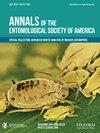Symbiotic Association Between Ants and Fungus
IF 1.8
3区 农林科学
Q1 ENTOMOLOGY
引用次数: 0
Abstract
Abstract Ants are eusocial insects belong to family Formicidae and live in symbiotic association with different species of the fungus. Fungi serving them as food and others relationship between fungus and ants is fungi increase the durability of the nest ants living in carton nests in the trees. Our goal was to investigate through literature obvious interactions between ants and common fungi, protection of ants' colonies from pathogens and uses of fungal isolates in sustainable agriculture. Fungal bank in the ants colony is their source of food and colonies of ants (Hymenoptera: Formicidae) are attacked by numerous parasites, pathogens, and parasitoids that exploit entire colonies and their resources. Symbiotic fungi strains belonging to Penicillium found in ants nests are antibiotic producer. High frequency and high diversity of these colonies suggested that insects preferentially sustained this fungus for their survival. Fungal growing ants evolved a close mutualistic relationship with multiple species of Actinobacteria belonging to the genus Pseudonocardia for protection of colony from various diseases. Fungus-growing ants and Pseudonocardia symbionts are novel and significant source of antibiotic and antifungal agents and used as model system due to experimental tractability and well-studied ecology. Beauveria bassiana, Metarhizium anisopliae and Lecanicillium psalliotae are Entomopathogenic fungi found in mutualistic association with Attine ants used in a much smaller scale. Formulation of entomopathogenic fungi-based pesticides biosynthesis of fungal-based nanoparticles at industrial scale is useful in recent sustainable agriculture. Graphical Abstract蚂蚁与真菌的共生关系
摘要蚂蚁是蚁科的真群居昆虫,与不同种类的真菌共生。真菌作为它们的食物,真菌和蚂蚁之间的其他关系是真菌增加了蚁巢的耐久性,蚂蚁生活在树上的纸箱巢中。我们的目标是通过文献调查蚂蚁与常见真菌之间的明显相互作用,蚂蚁群落免受病原体的保护以及真菌分离物在可持续农业中的应用。蚁群中的真菌库是它们的食物来源,蚁群(膜翅目:蚁科)受到许多寄生虫、病原体和类寄生虫的攻击,这些寄生虫会利用整个蚁群及其资源。在蚁巢中发现的青霉菌属的共生真菌菌株是抗生素的生产者。这些菌落的高频率和高多样性表明昆虫优先维持这种真菌的生存。为了保护蚁群免受各种疾病的侵袭,真菌生长蚁与假心菌属的多种放线菌进化出了密切的共生关系。真菌蚂蚁和假心菌共生体是一种新型的、重要的抗生素和抗真菌药物来源,由于其实验的可移植性和生态学研究的深入,被用作模型系统。球孢白僵菌、金龟子绿僵菌和蜡质乳杆菌是与蚂蚁共生的昆虫病原真菌,在较小的范围内使用。以昆虫病原真菌为基础的农药配方,以工业规模生物合成真菌为基础的纳米颗粒,在现代可持续农业中具有重要意义。图形抽象
本文章由计算机程序翻译,如有差异,请以英文原文为准。
求助全文
约1分钟内获得全文
求助全文
来源期刊
CiteScore
4.90
自引率
0.00%
发文量
25
审稿时长
6-12 weeks
期刊介绍:
The Annals of the Entomological Society of America exists to stimulate interdisciplinary dialogue across the entomological disciplines and to advance cooperative interaction among diverse groups of entomologists. It seeks to attract and publish cutting-edge research, reviews, collections of articles on a common topic of broad interest, and discussion of topics with national or international importance. We especially welcome articles covering developing areas of research, controversial issues or debate, and topics of importance to society. Manuscripts that are primarily reports of new species, methodology, pest management, or the biology of single species generally will be referred to other journals of the ESA. The most important criteria for acceptance are quality of work and breadth of interest to the readership.

 求助内容:
求助内容: 应助结果提醒方式:
应助结果提醒方式:


